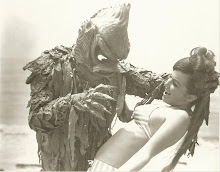The Spring 2009 issue of VideoScope includes my feature story on the making of American Scary, a documentary about TV horror movie hosts that has been playing the festival circuit for a few years and finally arrived on DVD back in February.
While researching regional horror films, I frequently encounter flicks that feature appearances by local movie hosts -- which only makes sense, since both phenomena originate from the same fount of plucky DIY regionalism that is, unfortunately, rapidly becoming extinct as our media continue to homogenize.
So in honor of American Scary, here is a list of regional horror films that feature appearances by local TV horror hosts. Did I miss any?
Tom Leahy (a.k.a. The Host), Kansas -- Leahy served as "The Host" half of The Host and Rodney on Wichita television for decades, and appeared in two very obscure horror and sci-fi films: Beast From the Beginning of Time (1965), which was never released theatrically, and King Kung Fu (1976), a comedy in which Leahy portrays a very John Wayne-like sheriff hot on the trail of a kung fu fighting gorilla.
George Ellis (a.k.a. Bestoink Dooley), Georgia -- Ellis not only hosted films on TV, but also programmed movies for a local arthouse cinema. You can see a nice pic of him by clicking on his name, and learn more about him at Mike Durrett's blog. He appeared as Bestoink in Legend of Blood Mountain (Legend of McCullough's Mountain/Blood Beast of Monster Mountain, 1965), a film with a production history that's nearly as convoluted as its myriad titles.
Charless Kissinger (a.k.a. The Fearmonger), Kentucky -- William Girdler's favorite actor was also a Louisville area horror host. You can see a picture of him as The Fearmonger here. He appeared in three of Girdler's Louisville horror productions, Abby (1974), Asylum of Satan (1972), and Three on a Meathook (1972), as well as The Zebra Killer (1974), Sheba Baby (1975), Grizzly (1976) and The Manitou (1978). He died in 1991.
Sid Noel (a.k.a. Dr. Morgus), Louisiana -- Noel is one of the few hosts to have a movie made about his onscreen character, The Wacky World of Dr. Morgus (1962).
Richard Dyszel (a.k.a. Count Gore de Vol), Maryland -- The Count was one of the first hosts to take his act to the Internet, where you can still see him in action at http://www.countgore.com/. He appeared in three Don Dohler projects in the 1980s, The Alien Factor (1978), Nightbeast (1982), and The Galaxy Invader (1985), as well as more recent films like Chainsaw Sally (2004).
J.G. "Pat" Patterson (a.k.a. The Mad Daddy), North Carolina -- Not to be confused with late Cleveland DJ and horror host Pete "Mad Daddy" Myers, Patterson was a magician and Spook Show host who also served as a special effects artist and/or producer on a number of H.G. Lewis, William Girdler and Frederick Friedel films. He starred in and directed The Body Shop (Doctor Gore, 1972).
Joe Alston (a.k.a. The Host), Texas -- Alston was also a kiddie show host, and you can see pictures of him here. He appeared as a demonic apparition in Pat Boyette's Dungeon of Harrow (Dungeons of Horror, 1962).
John Zacherle (a.k.a. Zacherley/Roland), New York -- One of the most famous hosts of all time, and still active today at http://www.zacherley.com/. Although Zach has been in a number of films, his only New York appearances between the late 1950s and 1990 were in Nick Zedd's Geek Maggot Bingo (1983) and Frank Hennenlotter's Brain Damage (1988) and Frankenhooker (1990)


